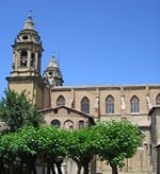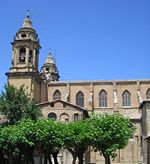
Cathedral of Pamplona
Encyclopedia

Santa María la Real
Santa María la Real is a monastery in the small town of Nájera in the La Rioja community, Spain. Originally a royal foundation, it was ceded by Alfonso VI to the Cluniac order. It was an important pilgrimage stop on the Camino de Santiago...
) is the Roman Catholic cathedral
Cathedral
A cathedral is a Christian church that contains the seat of a bishop...
of the archdiocese of Pamplona, Spain
Spain
Spain , officially the Kingdom of Spain languages]] under the European Charter for Regional or Minority Languages. In each of these, Spain's official name is as follows:;;;;;;), is a country and member state of the European Union located in southwestern Europe on the Iberian Peninsula...
. The current 15th century Gothic
Gothic architecture
Gothic architecture is a style of architecture that flourished during the high and late medieval period. It evolved from Romanesque architecture and was succeeded by Renaissance architecture....
temple replaced an older Romanesque
Romanesque architecture
Romanesque architecture is an architectural style of Medieval Europe characterised by semi-circular arches. There is no consensus for the beginning date of the Romanesque architecture, with proposals ranging from the 6th to the 10th century. It developed in the 12th century into the Gothic style,...
one. Archaeological excavations have revealed the existence of other two previous churches. The Neoclassical
Neoclassical architecture
Neoclassical architecture was an architectural style produced by the neoclassical movement that began in the mid-18th century, manifested both in its details as a reaction against the Rococo style of naturalistic ornament, and in its architectural formulas as an outgrowth of some classicizing...
façade
Facade
A facade or façade is generally one exterior side of a building, usually, but not always, the front. The word comes from the French language, literally meaning "frontage" or "face"....
was designed by Ventura Rodríguez
Ventura Rodríguez
Ventura Rodríguez Tizón was a Spanish architect and artist. Born at Ciempozuelos, Rodríguez was the son of a bricklayer. In 1727, he collaborated with his father in the work at the Royal Palace of Aranjuez.-Major works:...
in 1783. It has a 13th-14th century Gothic cloister
Cloister
A cloister is a rectangular open space surrounded by covered walks or open galleries, with open arcades on the inner side, running along the walls of buildings and forming a quadrangle or garth...
, that gives access to two other Gothic rooms: the Barbazan chapel and the refectory
Refectory
A refectory is a dining room, especially in monasteries, boarding schools and academic institutions. One of the places the term is most often used today is in graduate seminaries...
. The Mediaeval kings of Navarre
Kingdom of Navarre
The Kingdom of Navarre , originally the Kingdom of Pamplona, was a European kingdom which occupied lands on either side of the Pyrenees alongside the Atlantic Ocean....
were crowned there and some of them were also buried. The Navarrese Cortes (Parliament) was held there even during the early modern ages.
The temple
The site of the cathedral is the oldest part of the Roman Pompaelo. Archaeological excavations in 1994 have revealed streets and buildings from the 1st century BC. The oldest cathedral was demolished in 924 during the invasion of Abd-al-Rahman III, Caliph of Cordoba. During the reign of Sancho IIISancho III of Navarre
Sancho III Garcés , called the Great , succeeded as a minor to the Kingdom of Navarre in 1004, and through conquest and political maneuvering increased his power, until at the time of his death in 1035 he controlled the majority of Christian Iberia, bearing the title of rex Hispaniarum...
(1004–1035) was reconstructed. That temple was demolished from 1083 to 1097, and the Romanesque cathedral was built from 1100 to 1127. It collapsed in 1391, with only the façade remaining. The building of the current Gothic temple began in 1394 and lasted to 1501. The floorplan is cruciform
Cruciform
Cruciform means having the shape of a cross or Christian cross.- Cruciform architectural plan :This is a common description of Christian churches. In Early Christian, Byzantine and other Eastern Orthodox forms of church architecture this is more likely to mean a tetraconch plan, a Greek cross,...
with ambulatory
Ambulatory
The ambulatory is the covered passage around a cloister. The term is sometimes applied to the procession way around the east end of a cathedral or large church and behind the high altar....
, a central nave
Nave
In Romanesque and Gothic Christian abbey, cathedral basilica and church architecture, the nave is the central approach to the high altar, the main body of the church. "Nave" was probably suggested by the keel shape of its vaulting...
and four shorter aisles, all covered by partially polycromed rib vault
Rib vault
The intersection of two or three barrel vaults produces a rib vault or ribbed vault when they are edged with an armature of piped masonry often carved in decorative patterns; compare groin vault, an older form of vault construction...
. The style is very influenced by French
French Gothic architecture
French Gothic architecture is a style of architecture prevalent in France from 1140 until about 1500.-Sequence of Gothic styles: France:The designations of styles in French Gothic architecture are as follows:* Early Gothic* High Gothic...
models.
The sculpture of the interior includes the sepulchre
Sepulchre
The rock-cut tombs in ancient Israel are a group of hundreds of rock-cut tombs constructed in Israel in ancient times. They were cut into the rock, sometimes with elaborate facades and multiple burial chambers. Some are free-standing, but most are caves. Each tomb typically belonged to a...
of Charles III of Navarre
Charles III of Navarre
Charles III , called the Noble, was King of Navarre from 1387 to his death and Count of Évreux from 1387 to 1404, when he exchanged it for the title Duke of Nemours...
and spouse, by Jehan Lome de Tournai (1419), and the image of Royal Saint Mary, a Romanesque woodcarved silverplated sculpture. The choir
Choir
A choir, chorale or chorus is a musical ensemble of singers. Choral music, in turn, is the music written specifically for such an ensemble to perform.A body of singers who perform together as a group is called a choir or chorus...
, with its Renaissance choir stalls (1541), is separated from the nave by a Gothic iron grating (1517). There was a Renaissance retable
Retable
A retable is a framed altarpiece, raised slightly above the back of the altar or communion table, on which are placed the cross, ceremonial candlesticks and other ornaments....
(1598) in the presbytery
Presbytery (architecture)
The presbytery is the name for an area in a church building which is reserved for the clergy.In the oldest church it is separated by short walls, by small columns and pilasters in the Renaissance ones; it can also be raised, being reachable by a few steps, usually with railings....
, now in the church of Saint Michael in Pamplona. In the lateral chapels there are two Gothic retables (c.1500, 1507); one Italian Renaissance retable (16th century); one late Renaissance retable
Retable
A retable is a framed altarpiece, raised slightly above the back of the altar or communion table, on which are placed the cross, ceremonial candlesticks and other ornaments....
(1610, polycromed in 1617); and five Baroque retables (1642, 1683, 1685).
The cloister
Probably, the most outstanding element of the cathedral is its 13th century cloister. As the temple, the style followed the French Gothic architectureFrench Gothic architecture
French Gothic architecture is a style of architecture prevalent in France from 1140 until about 1500.-Sequence of Gothic styles: France:The designations of styles in French Gothic architecture are as follows:* Early Gothic* High Gothic...
, and the sculptural decoration is very rich. The door that gives access from the temple shows the Dormition
Dormition of the Theotokos
The Dormition of the Theotokos is a Great Feast of the Eastern Orthodox, Oriental Orthodox and Eastern Catholic Churches which commemorates the "falling asleep" or death of the Theotokos , and her bodily resurrection before being taken up into heaven. It is celebrated on August 15 The Dormition...
of the Virgin, and at the mullion
Mullion
A mullion is a vertical structural element which divides adjacent window units. The primary purpose of the mullion is as a structural support to an arch or lintel above the window opening. Its secondary purpose may be as a rigid support to the glazing of the window...
stands a 15th century sculpture of the Virgin Mary. The Barbazan chapel -named after the Pamplonese bishop buried there- is covered by a Gothic eight-rib vault. The so-called 'Precious Door' gives access to the ancient canons' dormitory and shows a complete sculptural story of the Virgin Mary's life. There are several notable burials: Bishop Miguel Sánchez de Asiáin's (14th century), Viceroy of Navarre Count of Gages' (Baroque
Baroque sculpture
Baroque sculpture is the sculpture associated with the Baroque cultural movement, a movement often identified with the existence of important Baroque art and architecture in non-absolutist and Protestant states.-Course:...
, 18th century) and guerrilla fighter Francisco Espoz y Mina's
Francisco Espoz y Mina
Francisco Espoz y Mina was a Spanish guerrilla leader and general.He was born at Idocin in Navarre. His father, Juan Esteban Espoz y Mina, and his mother, Maria Teresa Hundain y Ardaiz, belonged to the class of yeomen. Mina remained working on the small family inheritance until 1808...
(Neo-classical, 19th century). The lavatory is closed by a grid whose iron is said to be from the battle of Navas de Tolosa. Another decorated Gothic door gives access to the old kitchen and the refectory
Refectory
A refectory is a dining room, especially in monasteries, boarding schools and academic institutions. One of the places the term is most often used today is in graduate seminaries...
.
Diocesan Museum
The former canons' rooms house the Diocesan Museum. The main room is a 14th century rib-vault covered refectory. The adjacent kitchen is covered by a pyramidal stone-built chimneyChimney
A chimney is a structure for venting hot flue gases or smoke from a boiler, stove, furnace or fireplace to the outside atmosphere. Chimneys are typically vertical, or as near as possible to vertical, to ensure that the gases flow smoothly, drawing air into the combustion in what is known as the...
. This museum exhibits pieces of religious art from the cathedral and from many other Navarrese churches, many of them abandoned today: Romanesque, Gothic, Renaissance and Baroque sculpture, Gothic and Baroque painting, and 13th to 18th centuries goldsmith
Goldsmith
A goldsmith is a metalworker who specializes in working with gold and other precious metals. Since ancient times the techniques of a goldsmith have evolved very little in order to produce items of jewelry of quality standards. In modern times actual goldsmiths are rare...
and silversmith
Silversmith
A silversmith is a craftsperson who makes objects from silver or gold. The terms 'silversmith' and 'goldsmith' are not synonyms as the techniques, training, history, and guilds are or were largely the same but the end product varies greatly as does the scale of objects created.Silversmithing is the...
.
The most outstanding silversmith pieces are the Gothic Holy Sepulcher reliquary
Reliquary
A reliquary is a container for relics. These may be the physical remains of saints, such as bones, pieces of clothing, or some object associated with saints or other religious figures...
, made in 13th century Paris
Paris
Paris is the capital and largest city in France, situated on the river Seine, in northern France, at the heart of the Île-de-France region...
; the 14th century Lignum Crucis reliquary and the Renaissance 16th century processional monstrance
Monstrance
A monstrance is the vessel used in the Roman Catholic, Old Catholic, and Anglican churches to display the consecrated Eucharistic host, during Eucharistic adoration or Benediction of the Blessed Sacrament. Created in the medieval period for the public display of relics, the monstrance today is...
.

